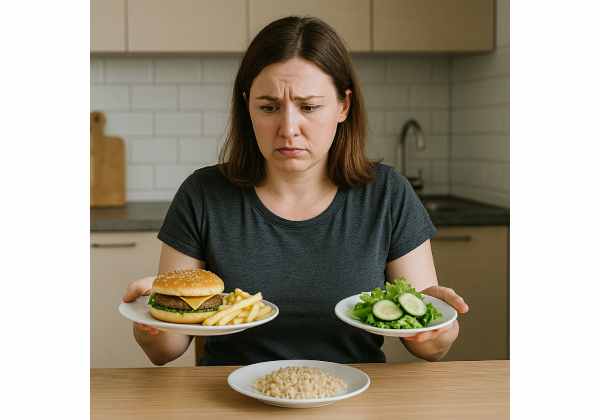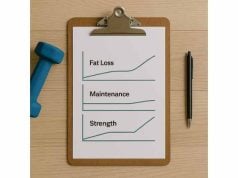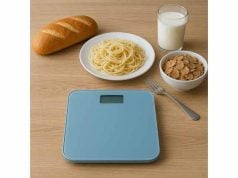
Five careful days can be undone by two loose ones. That is the quiet math behind many “plateaus.” You eat well Monday through Friday, train hard, and hit your steps. Then a dinner out, a few drinks, and snacks while streaming stretch into Sunday. By Monday, the weekly average is neutral or above maintenance. This guide explains the mechanics behind weekend overeating, shows the exact places calories hide, and gives you a weekend template you can keep year-round—without food rules or social isolation. If you are troubleshooting a stall right now, pair this article with our structured plateau and maintenance troubleshooting so you adjust the right lever at the right time.
Table of Contents
- Why weekend overeating erases deficits
- The math: five days on, two days off
- Triggers you can control
- Build a weekend budget
- Eating out and events
- Keep movement up
- Troubleshoot and when to pause
- Frequently Asked Questions
Why weekend overeating erases deficits
A calorie deficit does not care about your weekday streak; it sums across the entire week. Weekend overeating wipes out progress because the foods and settings common to Friday–Sunday combine high energy density, alcohol, and lower movement. Add late bedtimes, and Monday’s scale can show two to four pounds of temporary water from sodium and glycogen, disguising the real issue: your weekly average intake surpassed maintenance.
Where the extra energy comes from
- Liquid calories: cocktails, craft beer, sweet mixers, and large lattes. Two cocktails (~300–500 kcal) plus a beer (~150–250) can equal your weekday deficit.
- Restaurant portions and oils: entrees cooked in butter/oil add 100–300 kcal you never see; shared starters add another 200–400 before the main dish arrives.
- Grazing: “bites and tastes” at gatherings routinely reach 300–600 kcal across an evening.
- Hidden desserts: “just a few” cookies or chocolates while streaming often top 300 kcal.
Why weekends change your hunger and movement
- Sleep debt from late nights raises appetite and cravings the next day.
- Fewer anchors (set meal times, workday walks) lower NEAT: you sit more, park closer, skip stair habits.
- Social pacing makes it normal to eat past comfortable fullness; “I’ll get back on track Monday” loosens guardrails.
What to do first
- Treat Friday–Sunday as part of the same plan, not a break from it.
- Use two numbers: a weekend calorie budget (not a strict daily cap) and a step floor you will hit regardless of plans.
- Add pre-commitment to the calendar: choose the restaurant and the first round before the evening begins.
New to the basic nutrition and movement pieces that make deficits work? Skim our concise foundational guide to align calories, protein, and steps before you fine-tune weekends.
Key takeaways
- Weekly average intake—not weekday perfection—drives fat loss.
- Alcohol plus restaurant oils plus sleep debt usually explains Monday stalls.
- Plan weekends on purpose: a budget, a few rules that travel with you, and movement anchors.
The math: five days on, two days off
Let us quantify why “I’m good all week” still stalls. Imagine your maintenance is 2,300 kcal/day. You aim for a 500 kcal weekday deficit (1,800 kcal Mon–Fri). That creates 2,500 kcal of progress by Friday night. Then:
- Saturday: brunch (900), dinner out (1,300), two drinks (400) = 2,600 kcal (+300 over maintenance).
- Sunday: leftovers (800), snacks (600), takeout (1,200), dessert (300) = 2,900 kcal (+600 over maintenance).
Your weekly math:
- Mon–Fri: −2,500 kcal
- Sat–Sun: +900 kcal over maintenance
- Net: −1,600 kcal (≈0.45 lb theoretical loss)
But real life adds under-logged oils, more drinks, and lower steps. If each day hides +150–250 kcal, your weekday deficit shrinks by ~1,000 kcal. Now the weekly net approaches zero, and water from sodium and late meals masks any small loss.
Common weekend patterns and how to fix them
- Big brunch, no lunch, ravenous dinner: keep a protein-forward lunch (e.g., Greek yogurt bowl or chicken salad) even after brunch.
- Drink calories creep: pre-decide number and type of drinks; choose spirits with zero-calorie mixers or dry wine. Alternate with water.
- Grazing at home: set “closed kitchen” hours; prep a 150–250 kcal planned snack to prevent pantry laps.
Use weekly averages for sanity
- Track weekly calorie average and 7-day step average. If the trend is flat for two to four weeks, adjust the weekend budget first.
- Weigh daily but judge by weekly averages (not a single Monday spike). For a simple procedure, try our daily weight averaging method.
A better weekend distribution
- Friday: normal meals; dinner out with one planned drink.
- Saturday: slightly higher calories but protein at two meals and a planned dessert.
- Sunday: home-cooked, lighter dinner; early cutoff to improve Monday’s look and sleep.
This keeps the weekly average in a true deficit while letting you enjoy your plans.
Triggers you can control
Weekend overeating is not a willpower failure; it is the predictable result of cues, context, and fatigue. Replace the highest-impact triggers, and most “bad” weekends turn into ordinary, manageable ones.
Alcohol and appetite
Alcohol lowers restraint and raises snack appeal. The calories themselves matter less than the decisions they unlock. If drinks are a feature of your weekends:
- Pre-select number and type (e.g., two spirits with zero-calorie mixers).
- Place drinks with meals, not before, to cut grazing.
- Keep the final pour at least 3–4 hours before bed to protect sleep (and Monday water weight).
For a focused playbook on drinks, see the strategies in alcohol during weight stalls.
Sleep debt and late nights
Short nights increase next-day hunger and reduce NEAT. You also retain more water after late meals. Protect:
- Fixed wake time, even on weekends.
- Early evening cutoff for heavy food and alcohol.
- Morning light and a short walk to reset appetite cues.
Environment design
- Single-serve your most tempting snacks.
- Keep a fruit bowl and ready protein (Greek yogurt, cottage cheese, deli turkey, tofu) at eye level.
- Make the first round at restaurants a sparkling water or diet soda.
Social defaults
- Offer to choose the restaurant; pick a place with lean proteins and vegetable sides.
- Suggest a walk-and-talk first or after the meal.
- Use a one-minute menu scan: locate lean proteins, veg, and one carb you enjoy; commit before the server arrives.
Mood and stress
If weekends are your pressure valve, schedule non-food relief: a Saturday morning workout with a friend, a movie at the theater (built-in portion control), or a late-afternoon nap. When your nervous system is calmer, portions and drink count naturally shrink.
Build a weekend budget
Rigid rules crack on Friday night. Budgets bend without breaking. Create a two-day budget that fits your social life and preserves your weekly deficit.
Step 1: Set the numbers
- Estimate your maintenance and weekday deficit size.
- Allocate +300–600 kcal above your weekday target for Saturday and +100–300 for Sunday.
- Keep protein constant (1.6–2.2 g/kg goal body weight) and fiber 25–35 g/day; these are your satiety rails.
Step 2: Decide your “non-negotiables”
- Pick two indulgences that matter (e.g., dessert Saturday, two drinks Friday).
- Trade elsewhere: if dessert is non-negotiable, choose leaner mains and skip shared starters.
Step 3: Use planned buffers
- Add a high-volume lunch (salad + lean protein + potato/rice) before a big dinner.
- Keep a pre-event protein snack (yogurt + fruit; protein shake + banana) 60–90 minutes before going out.
Step 4: Guardrails that travel
- Order sequence: sparkling water → lean protein + veg → starch or dessert, not both.
- Plated portions: share starters; request sauces on the side.
- Closing ritual: mint tea or espresso after the main signals “meal over.”
If you are designing these numbers for the first time, our overview of maintenance macros shows how to keep protein and fiber steady while flexing carbs and fats for events.
A sample two-day plan
- Friday: Normal breakfast/lunch; dinner out with lean entrée, one side, one drink; 10-minute walk after.
- Saturday: Protein-heavy brunch; afternoon fruit + yogurt; dinner with dessert or two drinks (not both); home by 11; light evening snack if needed.
- Sunday: Early lighter dinner; no alcohol; 30–45 minutes easy movement.
This pattern keeps your weekend enjoyable while preserving the weekly deficit.
Eating out and events
Restaurant and party calories are not just about what you order; they are about defaults that add up: bread baskets, shared starters, oils, and desserts by habit. Use a few scripts and swaps to enjoy the night and keep your budget.
Simple menu scripts
- “I’ll have the grilled fish/chicken with double vegetables, potatoes on the side.”
- “Can we do dressing on the side and light oil?”
- “We’ll share one starter for the table.”
Smart swaps that satisfy
- Starters: salad with lean protein or grilled skewers instead of fried bites.
- Mains: grilled, baked, or seared proteins; starch you love (potatoes, rice) in a palm-to-fist portion.
- Dessert: share one, or choose fruit-forward options; pair with coffee or tea to slow the pace.
Portion cues in the moment
- Eat half, talk ten minutes, then check fullness.
- Leave a third of the starch if you want dessert.
- Ask for light oil—most kitchens will accommodate.
Home gatherings
- Bring a platter you want to eat (shrimp cocktail, veggie tray + Greek yogurt dip, fruit).
- Plate your food once; avoid grazing.
- Keep a zero-calorie drink in your hand between alcoholic drinks.
For satiety tactics that help you feel full on fewer calories, see our quick strategies in protein and fiber tactics—they translate directly to restaurant plates.
Keep movement up
Weekend movement often collapses: later mornings, longer drives, and fewer built-in walks. That quietly erases hundreds of calories of weekly burn and makes you feel sluggish—then you eat to wake up. Protect a step floor and sprinkle low-strain cardio where it fits.
Anchor walks
- After meals: two 10–12 minute walks (brunch, dinner) lower post-meal sleepiness and raise NEAT.
- Call rule: first 10 minutes of any call on foot.
- Evening loop: a short loop before the couch.
Step planning
- Check your 14-day average; set a weekend floor (e.g., 8,000).
- Put movement on the calendar like a reservation: Saturday 10:00 walk with a friend, Sunday afternoon park loop.
Low-strain cardio
- Two 20–30 minute easy sessions (treadmill, cycling, outdoor walk).
- Keep it conversational; save intervals for maintenance phases.
Weather and logistics
- Keep an indoor route (mall, parking garage, treadmill) ready for bad weather.
- Use rucking (light backpack) for variety once per week.
If weekends are where your daily movement drops, our playbook on preventing NEAT drops will help you hold the baseline during busy seasons.
Troubleshoot and when to pause
If you execute the weekend budget for two to four weeks and the weekly weight average, waist/hip measurements, photos, and clothes fit are unchanged, you likely have a true stall. Now choose the smallest effective change.
One-week triage
- Tighten logging of oils, condiments, drinks.
- Protein check: 1.6–2.2 g/kg daily; 25–40 g at breakfast and lunch.
- Step floor: hit your weekend target both days.
- Sleep repair: fixed wake time; caffeine cutoff 8–10 hours before bed.
Then pick one lever
- Movement: add +1,000–2,000 steps/day on the weekend or a third 20–30 minute easy cardio session.
- Calories: trim 100–200 kcal/day from carbs or fats (not protein) on Fri–Sun only; hold two weeks.
- Maintenance pause: spend 1–2+ weeks at calculated maintenance to restore training quality and mood; resume a small deficit afterward.
What not to do
- Slash calories across the week while leaving weekends chaotic.
- Add punishing cardio that wrecks sleep and adherence.
- Judge by one Monday weigh-in; always use weekly averages and measurements.
When you have stronger weeks ahead (fewer events, better sleep), keep your budget and push an extra 2,000–4,000 weekend steps to stack momentum.
Frequently Asked Questions
How many extra calories do weekends usually add?
Most stalls come from 600–1,500 unplanned calories across Friday–Sunday: drinks, restaurant oils, shared starters, and grazing. A two-drink night plus a richer entrée can erase a weekday deficit. Use a two-day budget, planned protein, and a step floor to keep the weekly average in a deficit.
Should I skip breakfast to “save up” for dinner?
Skipping often backfires with evening overeating. A better plan is a protein-forward breakfast and lunch (25–40 g each) and a light snack before the event. You will arrive calm, eat slower, and keep portions reasonable without feeling restricted.
Is it okay to have dessert and drinks on the same night?
Yes, but trade. If you want dessert, choose a lean entrée and skip shared starters, or limit to one drink. If you prefer drinks, skip dessert. Planning one indulgence per meal protects your weekly deficit while keeping meals enjoyable.
Do weekend steps really matter?
Absolutely. A drop from 9,000 to 4,000 steps can reduce daily expenditure by ~150–300 kcal. Two short walks after meals and a simple call-walking rule often restore weekend NEAT without formal cardio, helping your weekly average stay in a deficit.
How do I handle back-to-back events?
Use a two-day budget. Choose one meal as the feature (dessert or two drinks), and keep the other lean with extra vegetables and protein. Add an early lighter dinner on Sunday and a 30–45 minute easy walk both days to stabilize the average.
When should I raise calories or pause?
If weekly averages, waist/hip measurements, photos, and clothes fit are unchanged for 2–4 weeks despite solid weekends, consider a 100–200 kcal/day trim Mon–Sun or take 1–2+ weeks at maintenance. Preserve protein, sleep, and steps so you return to the deficit stronger.
References
- Effect of Sleep Extension on Objectively Assessed Energy Intake Among Adults With Overweight in Real-life Settings: A Randomized Clinical Trial 2022 (RCT)
- After Dinner Rest a While, After Supper Walk a Mile? A Systematic Review with Meta-analysis on the Acute Postprandial Glycemic Response to Exercise Before and After Meal Ingestion in Healthy Subjects and Patients with Impaired Glucose Tolerance 2023 (Systematic Review & Meta-analysis)
- Weekday-Weekend Differences in Chrononutritional Variables Depend on Urban or Rural Living 2024
- Effect of alcohol consumption on food energy intake: a systematic review and meta-analysis 2019 (Systematic Review & Meta-analysis)
- Dietary Guidelines for Americans, 2020-2025 and Online Materials | Dietary Guidelines for Americans 2020 (Guideline)
Medical Disclaimer
This article offers general education on weekend eating, energy balance, and weight management. It is not a substitute for professional medical advice, diagnosis, or treatment. Consult your licensed healthcare professional before changing your diet, exercise, medication, or alcohol use—especially if you have medical conditions or take prescriptions.
Share and Follow
If this guide helped you keep weekends from erasing your progress, consider sharing it with a friend who is in the same spot. You are welcome to follow us on Facebook, X, or whichever network you use for practical updates and step-by-step guides.










